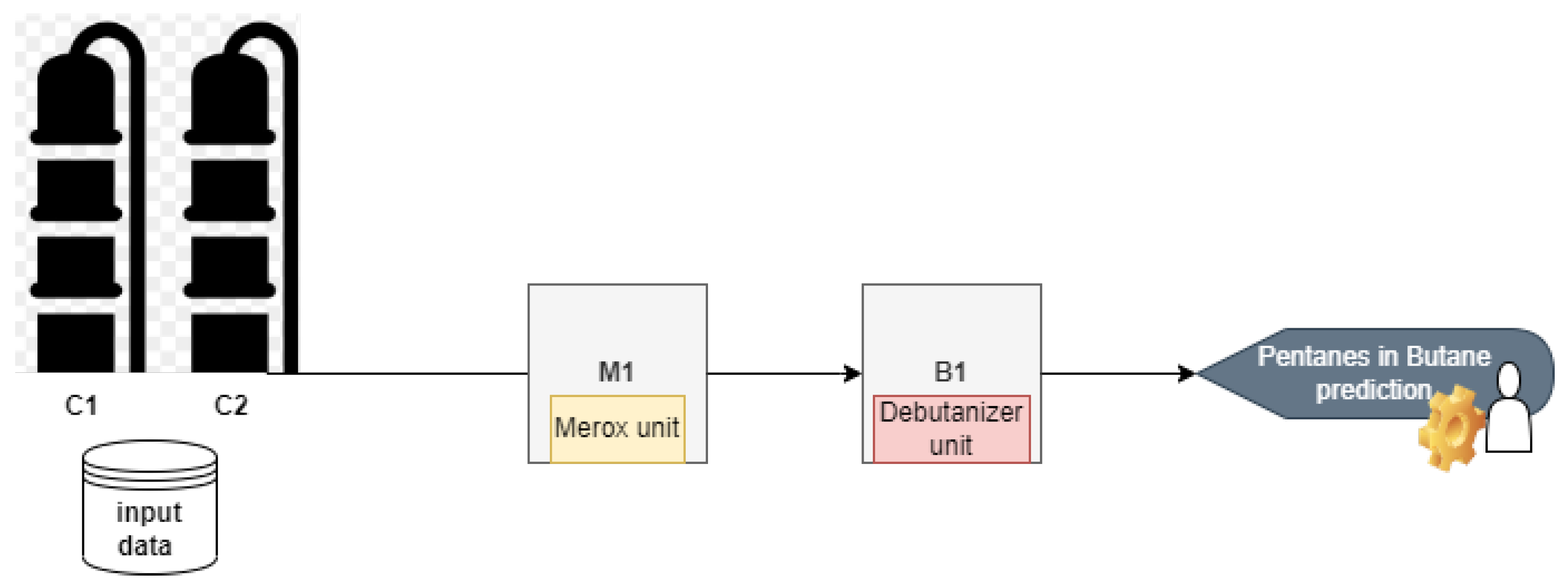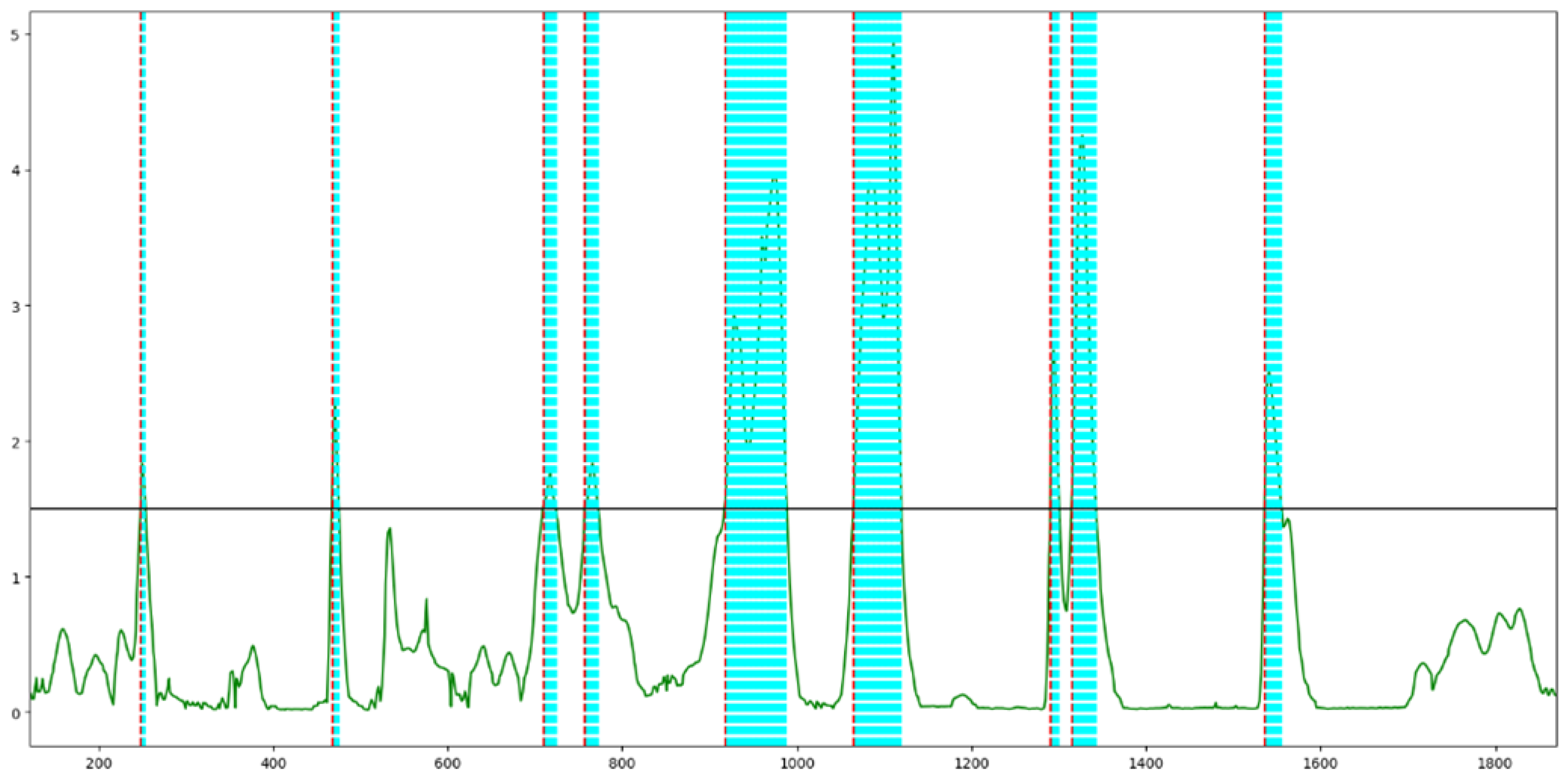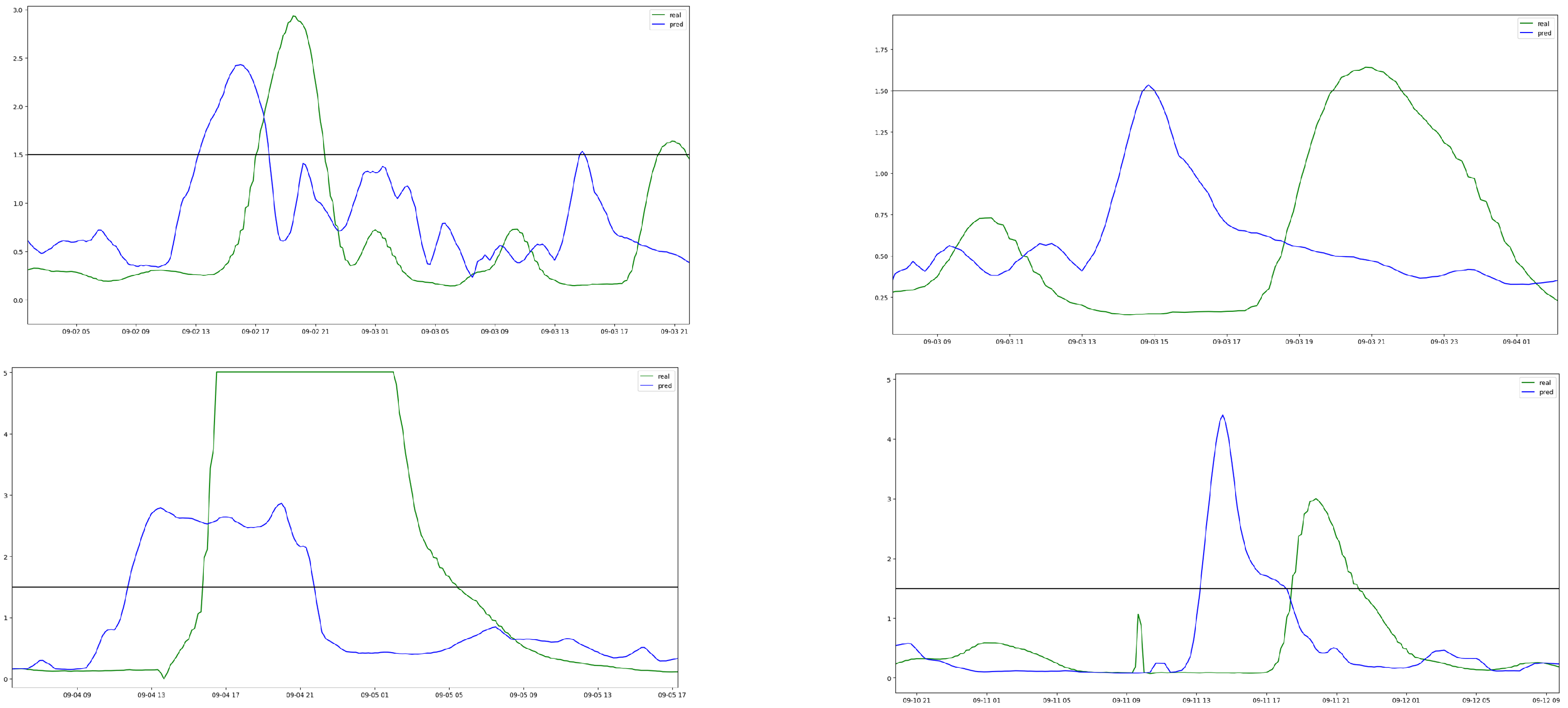Online Pentane Concentration Prediction System Based on Machine Learning Techniques †
Abstract
1. Introduction
2. Industrial Use Case Description
3. Percentage of Pentanes in Butane Prediction System
- True positives (TP) and timeTP1: Analyzing the real signal, when it exceeds the limit of , the time that the prediction takes to exceed that value is calculated (timeTP1time). If after 400 min the prediction does not exceed it, it means that the rise in Pentanes has not been detected sufficiently in advance and it is counted as FN.
- True positives (TP), timeTP2 and timeFP: Analyzing the real signal, when it exceeds the limit of , the time that the prediction is ahead in predicting the rise in Pentanes (timeTP2) is calculated. If it exceeds the maximum margin, it is computed as FP and timeFP is calculated, and if it is not exceeded, it is computed as TP and timeTP2 is allocated. When establishing this maximum time margin for timeTP2, it was agreed with the domain experts to consider 460 min (400 + 60).
- RF model implementation 1: introducing the previous values of Pentane concentration.
- RF model implementation 2: introducing different offsets in the process variables (offsets from −450 to −350 min) together with the previous values of Pentane concentration.
- RF model implementation 1 reduces the number of FPs up to window 11.
- RF model implementation 2 reduces the number of FPs up to window 9.
- The best approximation is that of RF model implementation 2 with SG of window 5 as it provides the best FP/TP ratio and timeTP.
- The best solutions for both approaches allow capturing 5-6 TPs out of a total of 8, generating 3-4 FPs.
- The FP/TP ratio is still quite high, around . That is to say, for approximately every 3 TPs we capture, 2 FPs are generated.
4. Conclusions
Author Contributions
Funding
Institutional Review Board Statement
Informed Consent Statement
Data Availability Statement
Conflicts of Interest
References
- Köksal, G.; Batmaz, İ.; Caner, M.; Testik, F. A review of data mining applications for quality improvement in manufacturing industry. Expert Syst. Appl. 2011, 38, 13448–13467. [Google Scholar] [CrossRef]
- Saihi, A.; Awad, M.; Ben-Daya, M. Quality 4.0: Leveraging Industry 4.0 technologies to improve quality management practices—A systematic review. Int. J. Qual. Reliab. Manag. 2023, 40, 628–650. [Google Scholar] [CrossRef]
- Zhang, R.; Jin, Q. Design and Implementation of hybrid modeling and PFC for oxygen content regulation in a coke furnace. IEEE Trans. Ind. Inform. 2018, 14, 2335–2342. [Google Scholar] [CrossRef]
- Wang, K.; Shang, C.; Yang, F.; Jiang, Y.; Huang, D. Automatic hyper-parameter tuning for soft sensor modeling based on dynamic deep neural network. In Proceedings of the IEEE International Conference on Systems, Man, and Cybernetics (SMC), Banff, AB, Canada, 5–8 October 2017; pp. 989–994. [Google Scholar]
- Niño-Adan, I.; Landa-Torres, I.; Manjarres, D.; Portillo, E.; Orbe, L. Soft-Sensor for Class Prediction of the Percentage of Pentanes in Butane at a Debutanizer Column. Sensors 2021, 21, 3991. [Google Scholar] [CrossRef] [PubMed]
- Yuan, X.; Huang, B.; Wang, Y.; Yang, C.; Gui, W. Deep learning-based feature representation and its application for soft sensor modeling with variable-wise weighted SAE. IEEE Trans. Ind. Inform. 2018, 14, 3235–3243. [Google Scholar] [CrossRef]
- Breiman, L. Random Forests. Mach. Learn. 2001, 45, 5–32. [Google Scholar] [CrossRef]
- Savitzky, A.; Golay, M.J.E. Smoothing and Differentiation of Data by Simplified Least Squares Procedures. Anal. Chem. 1964, 36, 1627–1639. [Google Scholar] [CrossRef]




| TPs | FPs | FP/TP | timeTP1 (min) min/mean/max—std | timeTP2 (min) min/mean/max—std | |
|---|---|---|---|---|---|
| RF | 93 | 145 | 1.55 | 20/274/390—99 | 400/445/450—12 |
| RF + SG w = 3 | 83 | 96 | 1.15 | 20/275/380—93 | 400/444/450—13 |
| RF + SG w = 7 | 70 | 68 | 0.97 | 20/253/370—94 | 380/425/430—10 |
| RF + SG w = 21 | 53 | 44 | 0.83 | 20/183/280—75 | 310/354/360—14 |
| TPs | FPs | FP/TP | timeTP1 (min) min/mean/max—std | timeTP2 (min) min/mean/max—std | |
|---|---|---|---|---|---|
| RF | 7 | 12 | 1.71 | 250/318/380—43 | 450/450/450—0 |
| RF + SG w = 3 | 7 | 10 | 1.42 | 140/293/370—73 | 440/440/440—0 |
| RF + SG w = 5 | 7 | 9 | 1.28 | 110/280/360—80 | 430/430/430—0 |
| RF + SG w = 7 | 7 | 7 | 1 | 100/270/350—80 | 410/410/410—0 |
| RF + SG w = 9 | 6 | 4 | 0.66 | 80/244/310—83 | 400/400/400—0 |
| RF + SG w = 11 | 5 | 3 | 0.6 | 70/230/290—80 | - |
| RF + SG w = 21 | 1 | 2 | 2 | 230/230/230—0 | - |
| TPs | FPs | FP/TP | timeTP1 (min) min/mean/max—std | timeTP2 (min) min/mean/max—std | |
|---|---|---|---|---|---|
| RF | 7 | 8 | 1.14 | 190/270/330—51 | 360/380/400—20 |
| RF + SG w = 3 | 6 | 5 | 0.83 | 240/285/320—35 | 360/380/400—20 |
| RF + SG w = 5 | 6 | 4 | 0.66 | 230/265/310—30 | 340/365/390—25 |
| RF + SG w = 7 | 6 | 4 | 0.66 | 210/255/300—36 | 330/355/380—25 |
| RF + SG w = 9 | 6 | 4 | 0.66 | 190/237/280—35 | 320/354/370—25 |
| RF + SG w = 11 | 4 | 3 | 0.75 | 210/240/270—30 | 310/330/350—20 |
| RF + SG w = 21 | 3 | 2 | 0.66 | 180/180/180—0 | 280/290/300—10 |
| TPs | FPs | FP/TP | timeTP1 (min) min/mean/max—std | |
|---|---|---|---|---|
| RF model implementation 2 online | 7 | 4 | 0.57 | 220/335/390—57 |
Disclaimer/Publisher’s Note: The statements, opinions and data contained in all publications are solely those of the individual author(s) and contributor(s) and not of MDPI and/or the editor(s). MDPI and/or the editor(s) disclaim responsibility for any injury to people or property resulting from any ideas, methods, instructions or products referred to in the content. |
© 2023 by the authors. Licensee MDPI, Basel, Switzerland. This article is an open access article distributed under the terms and conditions of the Creative Commons Attribution (CC BY) license (https://creativecommons.org/licenses/by/4.0/).
Share and Cite
Manjarrés, D.; Maqueda, E.; Landa-Torres, I. Online Pentane Concentration Prediction System Based on Machine Learning Techniques. Eng. Proc. 2023, 39, 77. https://doi.org/10.3390/engproc2023039077
Manjarrés D, Maqueda E, Landa-Torres I. Online Pentane Concentration Prediction System Based on Machine Learning Techniques. Engineering Proceedings. 2023; 39(1):77. https://doi.org/10.3390/engproc2023039077
Chicago/Turabian StyleManjarrés, Diana, Erik Maqueda, and Itziar Landa-Torres. 2023. "Online Pentane Concentration Prediction System Based on Machine Learning Techniques" Engineering Proceedings 39, no. 1: 77. https://doi.org/10.3390/engproc2023039077
APA StyleManjarrés, D., Maqueda, E., & Landa-Torres, I. (2023). Online Pentane Concentration Prediction System Based on Machine Learning Techniques. Engineering Proceedings, 39(1), 77. https://doi.org/10.3390/engproc2023039077







